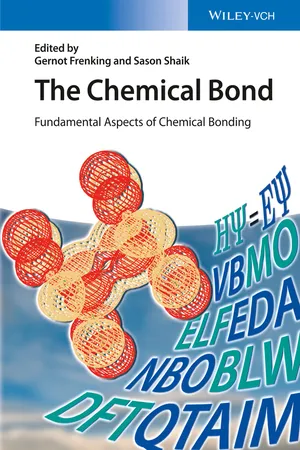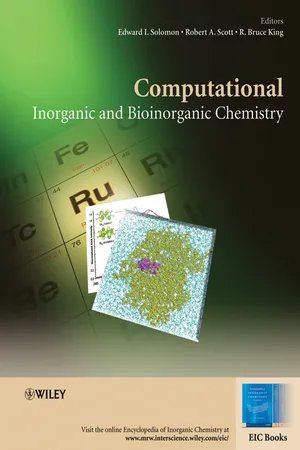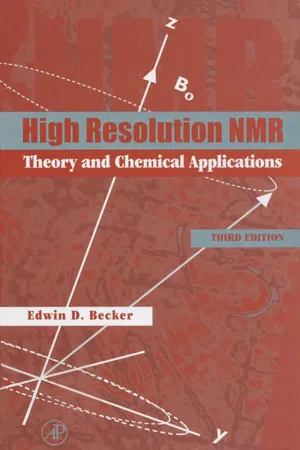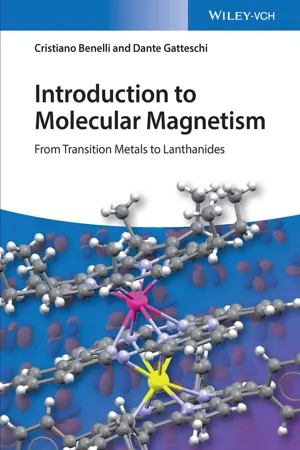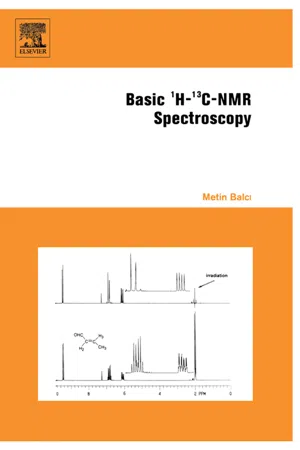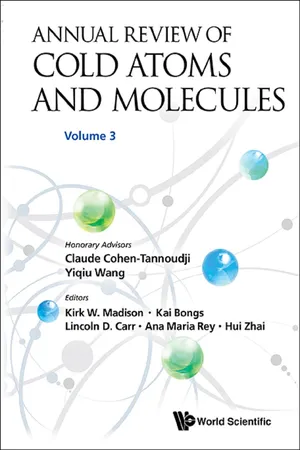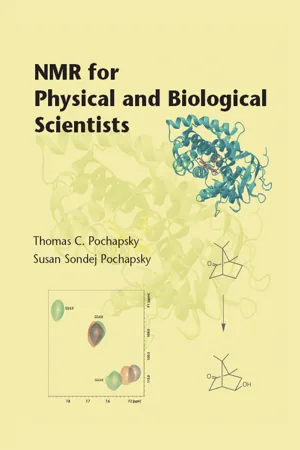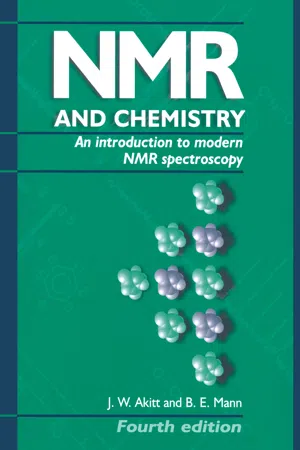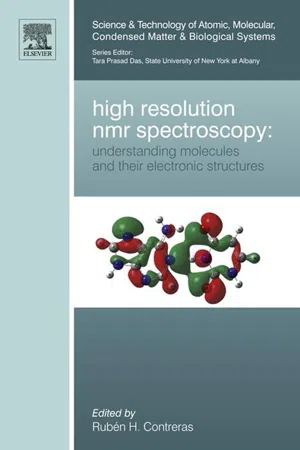Chemistry
Spin Orbit Coupling
Spin-orbit coupling is a phenomenon in which the spin of an electron interacts with its orbital motion and the magnetic field created by the nucleus. This interaction leads to splitting of energy levels and affects the electronic structure of atoms and molecules. In chemistry, spin-orbit coupling is important for understanding fine structure in atomic spectra and for predicting chemical reactivity.
Written by Perlego with AI-assistance
Related key terms
Related key terms
1 of 4
Related key terms
1 of 3
9 Key excerpts on "Spin Orbit Coupling"
- eBook - ePub
The Chemical Bond
Fundamental Aspects of Chemical Bonding
- Gernot Frenking, Sason Shaik, Gernot Frenking, Sason Shaik(Authors)
- 2014(Publication Date)
- Wiley-VCH(Publisher)
As an example, we mention superheavy element Fl (Z = 114) with a closed-shell configuration, which is assumed to be chemically inert. Current one-atom-at-a-time experiments are designed around this chemical property [79]. The relativistic stabilization of the p 1/2 -shell is already seen in the trend down the periodic table for the Group 13 and 14 elements. An important implication of the spin–orbit coupling is that the special stability of a half-filled p -shell (p 3) loses its significance for the heavy elements [41]. A further complication arises from the fact that spin-symmetry has to be included allowing for half-integer angular momenta. Bethe [80] therefore introduced an additional rotation R by 360 ° into molecular point-groups (which for single point-groups leads to the identity), resulting in the so-called double groups, as it doubles the number of operations. Here either the Bethe (Γ j -notation) or the Mulliken–Herzberg notation (labeled according to their dimensionality) is used for labeling irreducible representations in double groups, except for linear molecules where one uses conveniently the ω–ω -coupling notation. For example, a 3 Π state of a diatomic molecule splits into four states of 0 +, 0 −, 1, and 2, originating from products of spin and spatial symmetry. Double-group symmetry is extensively used in ligand- or crystal-field theory when strong spin–orbit coupling is encountered [81]. For example, a 4 F atomic state (e.g., the ground state of Cr 3+) splits into four levels because of spin–orbit coupling (4 F 3/2, 4 F 5/2, 4 F 7/2, 4 F 9/2), and further in a total of nine levels in a cubic ligand field, which are characterized by their double-group irreducible representations. For further information the reader is referred to standard textbooks in group theory [82], and to an excellent review by Leszczynski and coworkers [83] - Edward I. Solomon, Robert A. Scott, R. Bruce King, Edward I. Solomon, Robert A. Scott, R. Bruce King(Authors)
- 2013(Publication Date)
- Wiley(Publisher)
Spin-Orbit Coupling: Effects in Heavy Element Chemistry Nikolas Kaltsoyannis University College London, London, UK1 INTRODUCTION
1.1 General Considerations
The effects of relativity upon the physical and chemical properties of heavy elements are by now well established and documented,1 –5and space does not permit the present contribution to give anything other than a brief summary of the background material. The principal so-called scalar relativistic effect in atoms is the modification of electronic wavefunctions and energies, an effect that can be split into two parts; namely, direct orbital contraction and indirect orbital expansion. The former applies primarily to all s and, to a lesser extent, p orbitals, and may be explained as follows.1 ,6The inner core electrons move with radial velocities that are appreciable fractions of the speed of light. These high velocities lead to modifications in electron mass and radial extension, producing a contraction of the orbital. The atomic orbitals (AOs) of the same l but higher n value then also contract to ensure orthogonality with the core functions. An alternative explanation7 holds that the orthogonalization of high n (valence) s and p functions on the core AOs actually leads to a small expansion of the valence orbitals. The overall contraction of these valence orbitals is in fact due to the mixing in of orbitals higher in energy (especially continuum orbitals) by the relativistically modified Hamiltonian.Notwithstanding the origin of the direct orbital contraction, the indirect orbital expansion describes the effect of relativity on valence d and f functions. It arises from increased shielding of the nucleus as a result of the direct contraction of the outer core s and p electrons of similar radial distribution to the d and f functions. For very heavy elements such as the 5d, 6p, and 5f elements, the relativistic modification of the valence AOs is very significant. Therefore, computational treatments of these elements and their compounds should really incorporate these AO modifications to the largest possible extent.- eBook - ePub
High Resolution NMR
Theory and Chemical Applications
- Edwin D. Becker(Author)
- 1999(Publication Date)
- Academic Press(Publisher)
J on γ means that the coupling constant itself (but not the reduced coupling constant) changes with isotopic substitution even though the electron distribution in the molecule is unchanged. For example, on deuterium substitution,J HX/J DX=γ H/γ D= 6.51(5.2)5.3 THEORY OF SPIN-SPIN COUPLING
For proton—proton coupling it has been shown that the spin interaction arises principally from the electron spin-electron spin interaction, not from orbital interaction of electrons. This simplifies the theory somewhat. For some other nuclei, orbital interaction may also come into play. We shall summarize a few of the conclusions applicable to spin—spin coupling without going through the details of the theory.From our qualitative description of the origin of spin coupling, it is clear that the interaction depends on the proximity between electron and nuclear spins, and a quantitative treatment verifies that the interaction depends on density of electrons at the nucleus. It is well known that only s electrons have density at the nucleus, so we expect a correlation between the magnitude of the coupling and the s character of the bond. Such a relation is found, as we see in the following section.The theoretical development of the electron-coupled spin—spin interaction has been carried out principally by second-order perturbation theory, just as is done with shielding by electrons. In Section 4.2 we mentioned some of the problems in applying ab initio methods to calculation of shielding. For calculation of spin coupling, many of these problems remain, and it is also necessary to use basis sets that correctly represent the electron wave function at the nucleus. Unfortunately, Gaussian functions, which are widely used because of the relative ease of computing large basis sets, do not meet this requirement, so special basis sets must be employed. Ab initio - eBook - ePub
Introduction to Molecular Magnetism
From Transition Metals to Lanthanides
- Cristiano Benelli, Dante Gatteschi(Authors)
- 2015(Publication Date)
- Wiley-VCH(Publisher)
8 Molecular Orbital of Coupled Systems8.1 Exchange and Superexchange
In this chapter, we will focus on the results of calculations of spin Hamiltonian (SH) parameters using basic theories such as ab initio and density functional theory (DFT). This is a field that has been explored using adequate theoretical models only in the past few years but the obtained results are quite encouraging. The background needed to justify the nature of the interaction responsible of the cooperative phenomena that make all varieties of physical properties so fascinating is still the approach first taken by Anderson in the early 1950s (Anderson, 1950, 1959). Here we summarize Anderson's model essentially to introduce the language that has been used ever since the introduction.At the simplest possible level, let us assume two systems characterized by having one unpaired electron each. The systems can be general, but we will start from metal-containing moieties. They can be schematized as shown in Figure 8.1 . We may assume that the ground state of the two systems, in the absence of interaction, is given by two orbitals ϕA and ϕB , which we will call magnetic orbitals. The system in zero-order approximation is assumed to be orbitally nondegenerate. The interaction between A(B) and C is weak in such a way that the electron density is mainly concentrated on the metal centers A and B, but spin polarization will give a nonzero density also on the bridging ligands. As we will see, this can be of paramount importance in determining the mechanism of interaction and the magnetic properties.Schematic diagrams for the mechanism of the (a) antiferromagnetic and (b) ferromagnetic kinetic exchange: orbital population is in the ground spin-singlet state. (Reproduced from Palii, A. et al. (2011) with permission from The Royal Society of Chemistry.)Figure 8.1Switching on the interaction requires us to define excited states and their admixture with the ground ones. This can be done by defining charge transfer processes in which one electron is transferred from an orbital localized on A to one centered on B (and/or vice versa). For the moment, we may assume that there is one unpaired electron on each atom. There are two types of charge transfer processes: (i) from a half-filled orbital to a half-filled orbital, and (ii) from a half-filled orbital to an empty one. The energies involved in the charge transfer are the electron–electron Coulomb repulsion U, due to the presence of two electrons in the same orbital with high density on one metal ion. The other contribution is the electron transfer that is associated with the transfer integral between the ϕA and ϕB orbitals, which is indicated by . This term depends on the kinetic energy of the electron and is calledkinetic exchange. The excited state determined by charge transfer has an state which is admixed with the corresponding one with stabilizing it. For the charge transfer , the interaction energy is . The states generated by the transfer can be classified as singlet and triplet. By applying second-order perturbation theory, the contribution of the - eBook - ePub
- Metin Balci(Author)
- 2005(Publication Date)
- Elsevier Science(Publisher)
Before considering the factors that affect the spin–spin coupling constants let us discuss briefly the mechanism of the spin–spin coupling interaction. How does spin–spin coupling arise?Although there are three different mechanisms that contribute to spin–spin coupling, the Fermi contact term mechanism is the dominant one for all couplings involving hydrogen. According to this mechanism, the spin–spin coupling between two nuclei A and B arises from the interaction of nuclear spins A and B, which involves the bonding electrons connecting these nuclei. A and B can be either of the same isotope or of different isotopes attached by one bond. We can use a greatly simplified model to understand the coupling mechanism, taking as an example the 1 H–13 C molecule. Two atoms are bonded by a σ-bond having two electrons. The coupling mechanism for the 1 H–13 C coupling can be visualized as follows (Figure 55 ).Figure 55 Schematic representation of the spin–spin interaction (proton and carbon) through the bonding electrons in a C–H bond.The magnetic moment of the hydrogen atom 1 H can be either parallel or antiparallel to the applied field. We begin first with the ground state orientation of the hydrogen atom 1 H, which has a parallel orientation. The energetically preferred state is that in which the nuclear magnetic moment of the hydrogen atom 1 H and the magnetic moment of the nearest bonding electron are in an antiparallel configuration. According to the Pauli principle , the two electrons in the bond between the nuclei must have their spins paired. Therefore, the magnetic moment of the second electron adjacent to 13 C will have an orientation parallel to the applied field, which will force the nuclear magnetic moment of the carbon atom 13 C to align itself antiparallel to the applied field. In this way each nucleus responds to the orientation of the other. The antiparallel orientation of H will force carbon atom 13 C to align itself in parallel orientation to the applied field in the same manner. Consequently, the magnetic field around the resonating nucleus will be affected by the orientation of the adjacent nucleus. In this particular case, the nuclear magnetic moment of one nucleus forces the nuclear magnetic moment of the other nucleus (through the interaction with the bonding electrons) to be in the opposite direction, in a stable state. In this case, the coupling constant is defined as having a positive sign. All 13 C–1 - eBook - ePub
- Kirk W Madison, Kai Bongs, Lincoln D Carr, Ana Maria Rey, Hui Zhai(Authors)
- 2015(Publication Date)
- WCPC(Publisher)
Ref. 86 , such a modification can lead to an integer Hall conductivity even though the underlying free-particle band structure is trivial. In the language of the slave-boson picture discussed above, this means the spontaneous ordering of spins in the Mott insulator leads to time-reversal breaking, and an extra added charge boson (particle or hole in this case), which senses local orbital magnetic fields on plaquettes, can develop a gapped, topologically nontrivial, band structures with nonzero Chern numbers.4.Future prospects
In this article, we first reviewed several experimental schemes currently employed to study the spin-orbit coupling in cold atoms in the continuum as well as in optical lattices. In the later case, we concentrate on the interplay between the strong onsite interaction and the spin-orbit coupling and point out several novel phenomena associated with them. Theoretically, a few outstanding questions remain to be understood in SOBHM.•What is the nature of the superfluid to Mott insulator phase transitions in the presence of spin-orbit coupling? How does the density or spin modulation in the superfluid state modify the critical properties of the transition?•It is necessary to better characterize the superfluid state by, for example, calculating and measuring the superfluid and spin superfluid density. The same problem remains to be done in the case of spin-orbit coupled quantum gases in the absence of an optical lattice. - eBook - ePub
- Thomas C. Pochapsky, Susan Pochapsky(Authors)
- 2006(Publication Date)
- Garland Science(Publisher)
J-coupled. Coupling is a two-way street, and if nucleus A affects B, nucleus B also affects A, and to the same extent.The difference between the resonance frequency of spin B when A is m = +1/2 versus when A is m = −1/2 (and vice versa) is called the coupling constant and is usually designated as JAB . We will see later that the J-coupling term in the spin Hamiltonian operator does not depend on magnetic field strength, and is a property of the molecular structure. Because of this, unlike chemical shift, the magnitude of the coupling constant does not depend on the magnitude of B0 (see Figure 2.7 ).Figure 2.7 The integrated 1 H NMR spectrum of ethanol. Normalized signal integrations are shown below the chemical shift scale, and correspond to the number of protons contributing to the particular signal. The signal marked with an asterisk is due to trace H2 O.The appearance of the spectrum of a compound containing coupled spins depends on the magnitude of the coupling constant(s) and to how many other spins a given spin is coupled. In the simplest case, two distinct nuclei, A and X, are coupled, and the coupling constant JAX is much smaller than the difference between the resonance frequencies of A and X in hertz. This condition JAX <<|νA − νX | is called the weak coupling case, and spectra in which only weak coupling is observed are called first-order spectra. In a first-order two-spin spectrum, each resonance is split into two lines (a doublet) that correspond to the transition frequencies of the resonant spin when the coupling partner is in either the lower or upper spin state, and the splitting between the two lines exactly equals the coupling constant. The chemical shift of a resonance in this case is taken as exactly at the midpoint of the doublet (Figure 2.8 ). As the coupling constant becomes larger relative to the difference in chemical shift (JAX ≈|νA − νX - eBook - ePub
NMR and Chemistry
An introduction to modern NMR spectroscopy, Fourth Edition
- J.W. Akitt, B. E. Mann(Authors)
- 2017(Publication Date)
- CRC Press(Publisher)
B are the magne- togyric ratios of the interacting nuclei.The valence s electron density at the nucleus and therefore upon the s character of the bonding orbitals. This factor also means that the interaction increases periodically as the atomic number of either or both nuclei is increased in the same way as does the chemical shift range.The magnitude of the coupling interaction is measured in hertz (Hz) since it is independent of the magnetic field strength. It is called the coupling constant and is given the symbol J ; its magnitude is very variable and values have been reported from 0.05 Hz up to thousands of hertz. The value of J gives information about the bonding system but this is obscured by the contribution of γA and γB to J . For this reason correlations between the bonding system and spin-spin coupling often use the reduced coupling constant, K, which is equal to 4π2 J /hγA γB.It is important to understand that coupling constants can be either positive or negative and that the frequency of one nucleus may be either increased or decreased by a particular orientation of a coupled nucleus, the sign depending upon the bonding system and upon the sign of the product γA γB .Considerable data are available upon the magnitudes of interproton spin coupling constants from the mass of data accumulated for organic compounds. Interproton coupling is usually (though not always) largest between geminal protons (H–C–H), and depends upon the angle between the two carbon-hydrogen bonds. J gem is typically –12 Hz in saturated systems. J falls rapidly as the number of intervening bonds is increased, being 7 to 8 Hz for vicinal protons (H–C–C–H) and near zero across four or more single bonds. The same rules apply if oxygen or nitrogen forms part of the coupling path, and methoxy protons (H3 COCHR2 ) do not usually show resolvable coupling to the rest of the molecule, though alcoholic or amino protons may do so to vicinal protons in, for example, HOCH3 . On the other hand, coupling may be enhanced if there is an unsaturated bond in the coupling path, due to a σ-π configuration interaction, and may be resolved over up to as many as nine bonds, e.g. 9 J (H–H) = 0.4 Hz between the hydrocarbon protons in H3 C(C≡C)3 CH2 - eBook - ePub
- (Author)
- 2013(Publication Date)
- Elsevier(Publisher)
Chapter 6Analysis of Contributions to Spin–Spin Coupling Constants by the Natural J -Coupling Method
J.M. García de la Vega and J. San Fabián, Departamento de Química Física Aplicada, Facultad de Ciencias, Universidad Autónoma de Madrid, Madrid, Spain Dedicated to the memory of Joaquín Guilleme.Abstract
Natural bond orbital and natural J -coupling methods are used for the analysis of the Fermi-contact contributions to spin–spin coupling constant (SSCC). In this way, the SSCCs are partitioned into three contributions: Lewis, delocalization, and repolarization. This partition is applied to the study of some chemical systems to explain the main electron delocalization effects on SSCCs.Keywords
NMR; Spin–spin coupling constants; Natural bond orbitals; Natural J -coupling; Electron delocalization effects1 Introduction
Nuclear magnetic resonance (NMR) spectroscopy is a powerful tool for the determination of molecular electronic structure and molecular conformation. Together with chemical shifts, indirect nuclear spin–spin coupling constants (SSCCs) are the most important source of structural information in high-resolution NMR. SSCC values depend on the electron distribution between the coupled nuclei and, consequently, they are very sensitive to the molecular geometry. The first dependence provides valuable information on chemical bonding, while the second one allows SSCC to be used extensively in conformational studies. However, the extraction of that information is not straightforward and a careful analysis and interpretation of the results is required.
Index pages curate the most relevant extracts from our library of academic textbooks. They’ve been created using an in-house natural language model (NLM), each adding context and meaning to key research topics.
Explore more topic indexes
Explore more topic indexes
1 of 6
Explore more topic indexes
1 of 4
